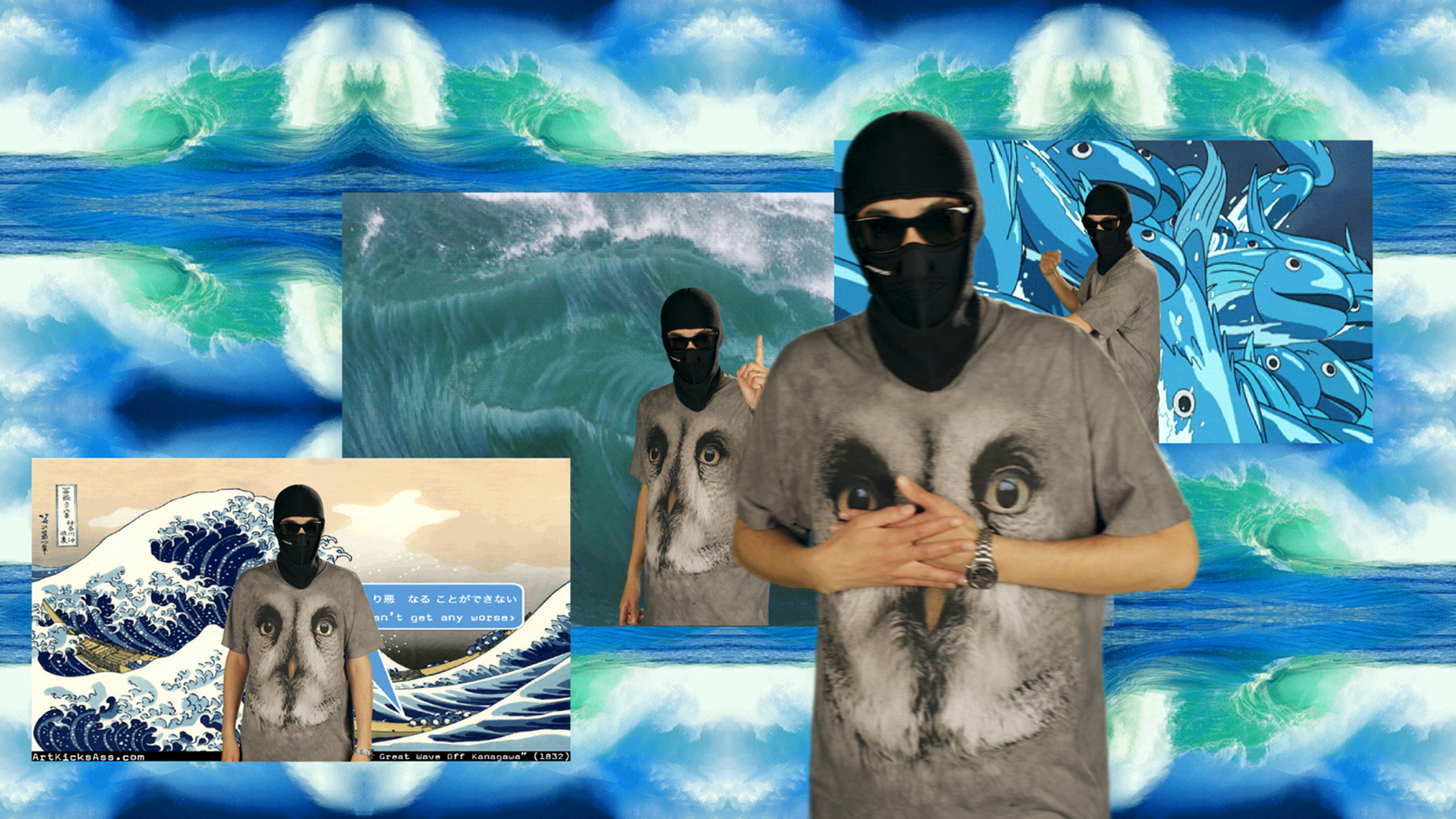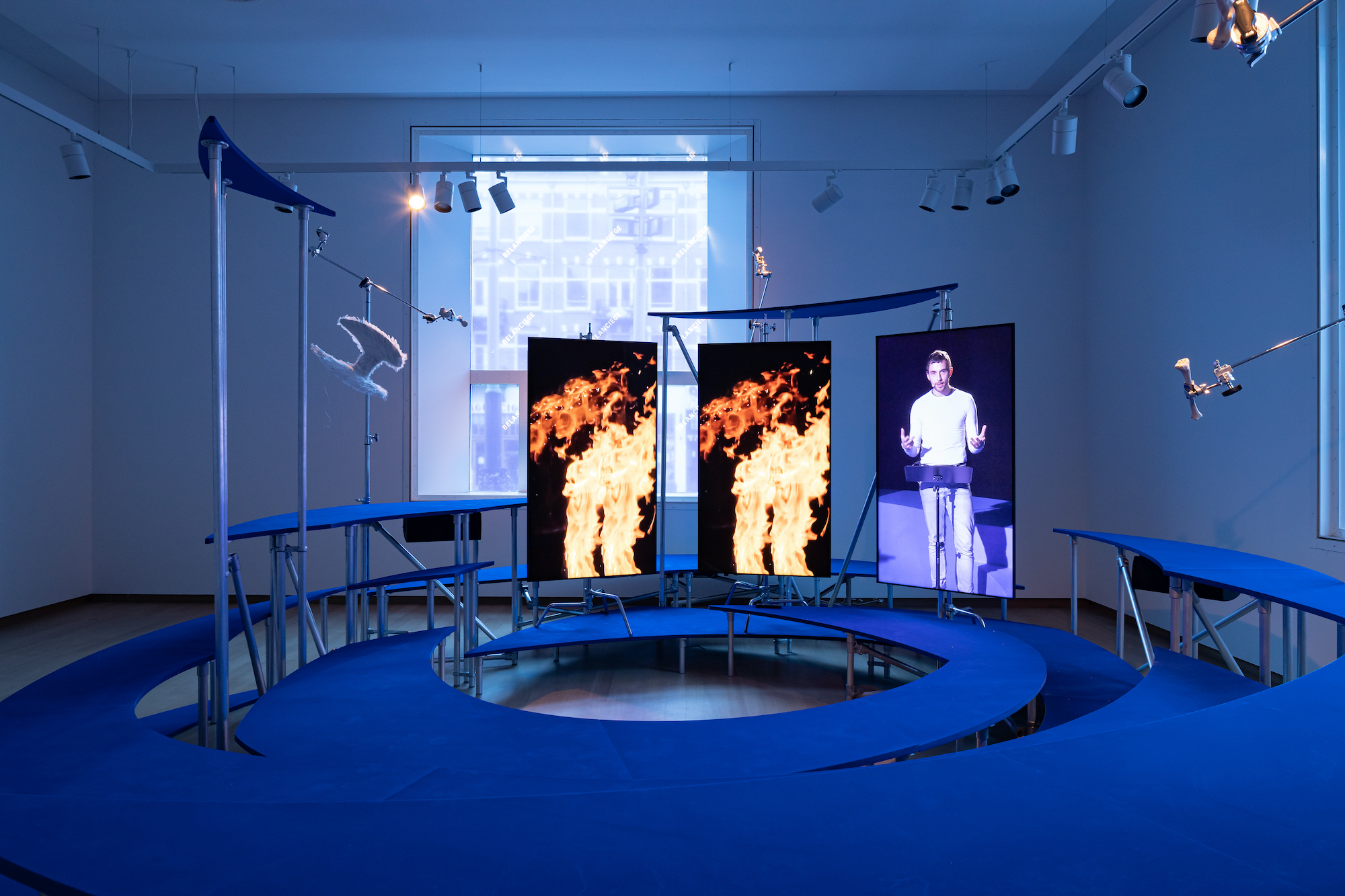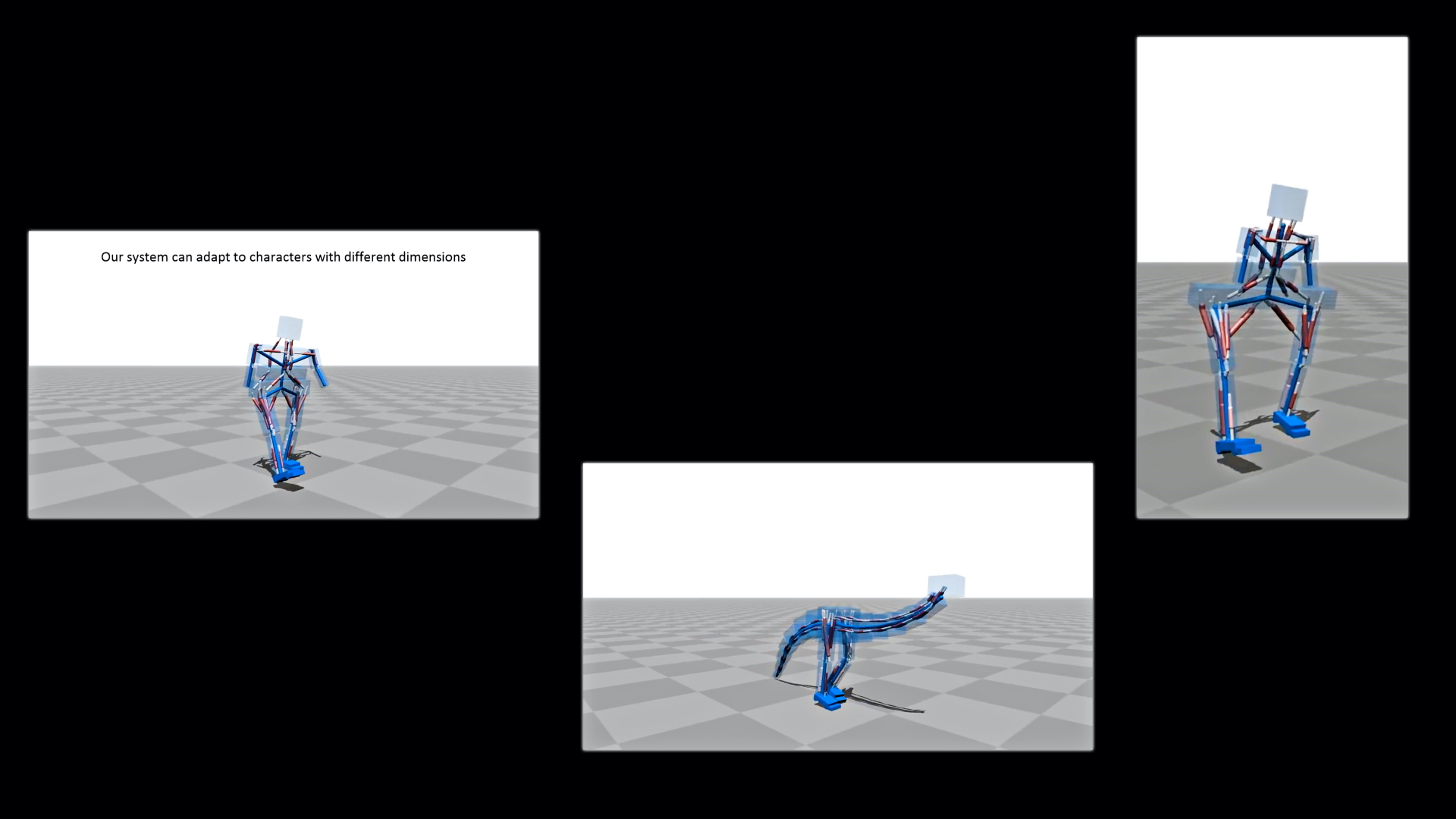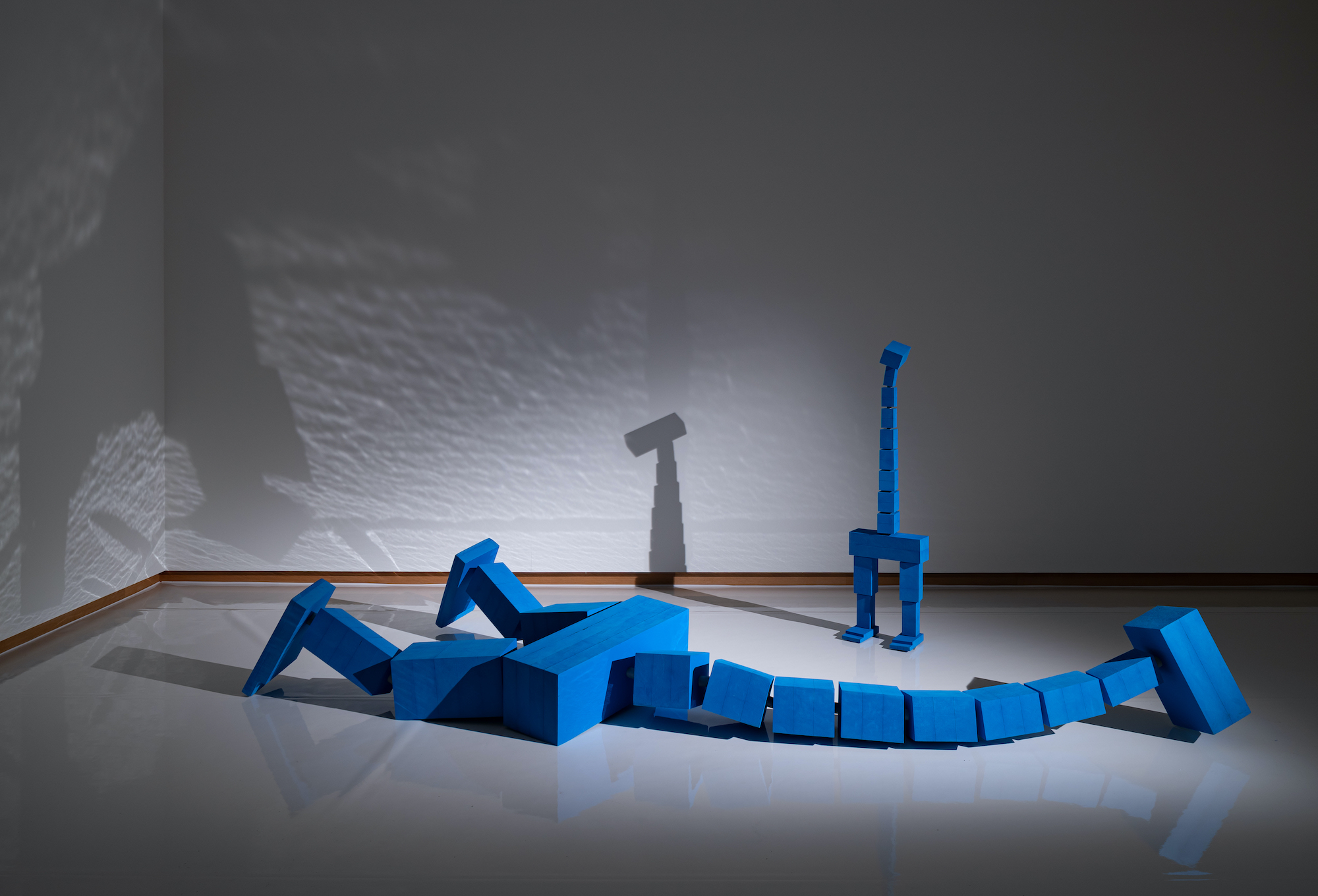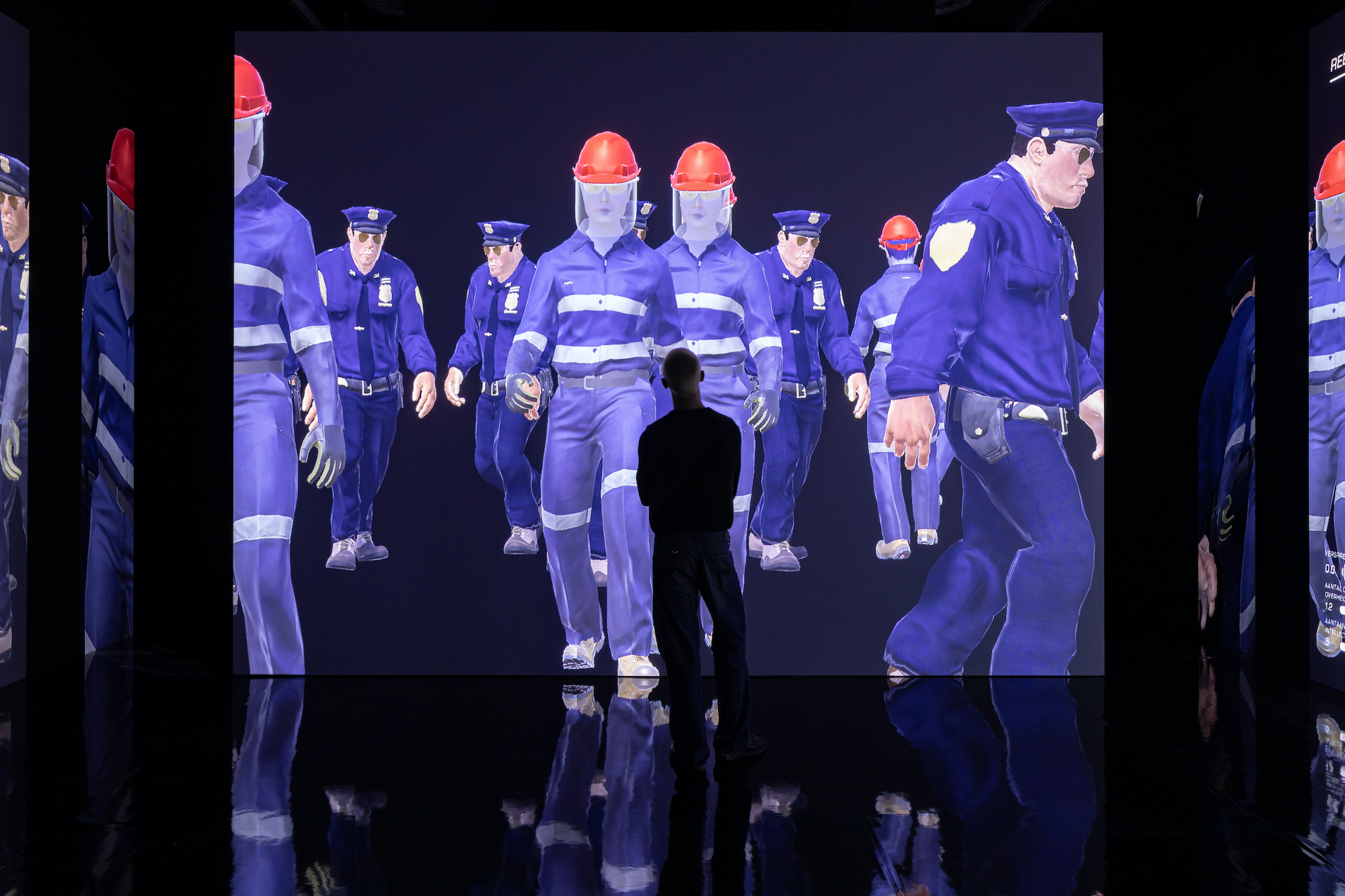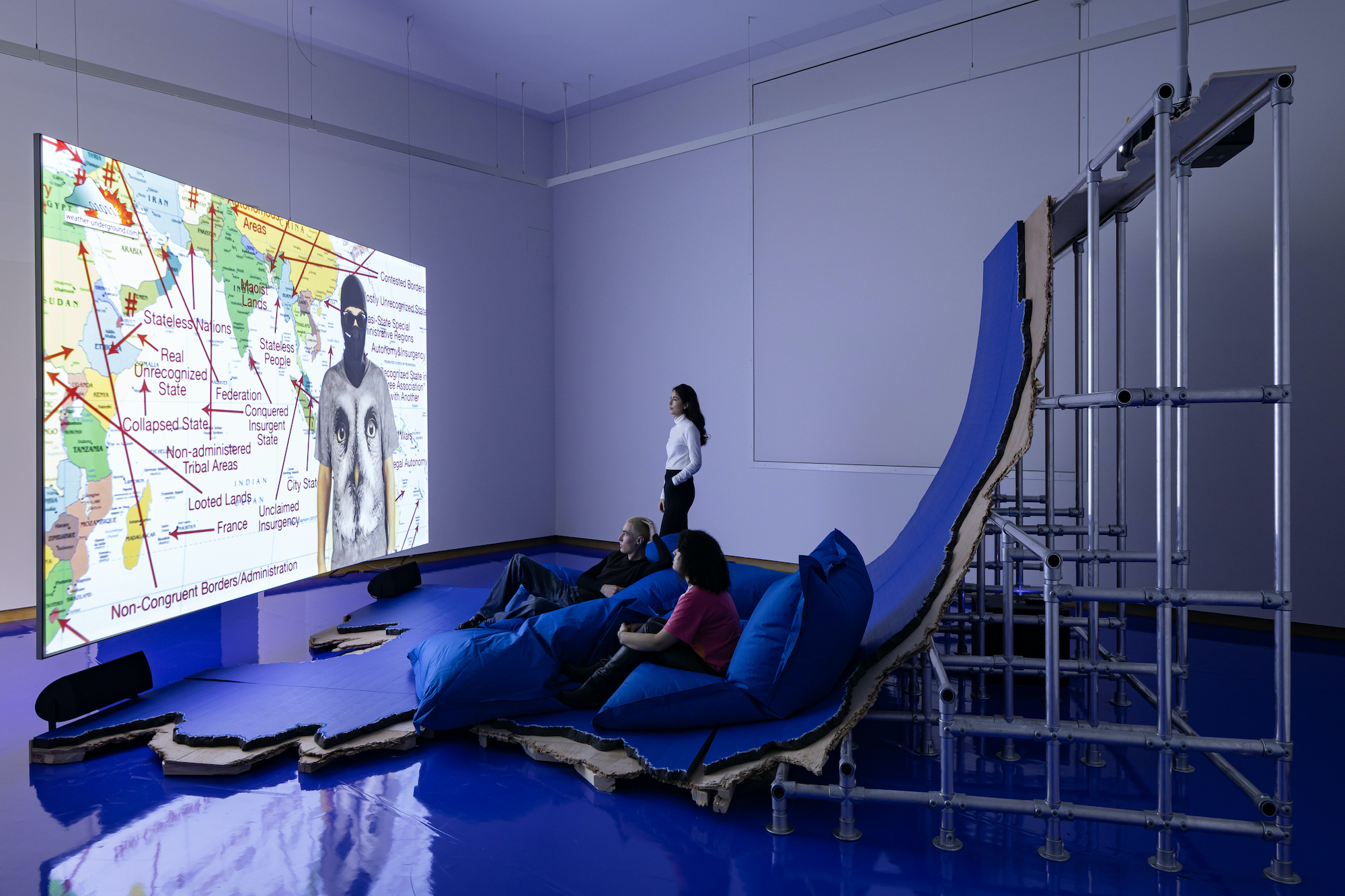
Hito Steyerl, I Will Survive, installation view, 2022 [photo: Peter Tijhuis; courtesy of the artist and Stedelijk Museum Amsterdam]
Hito Steyerl: I Will Survive
Share:
Data, sounds, and images are now routinely transitioning beyond screens into a different state of matter. They surpass the boundaries of data channels and manifest materially. They incarnate as riots or products, as lens flares, high-rises, or pixelated tanks. Images become unplugged and unhinged and start crowding off-screen space. They invade cities, transforming spaces into sites, and reality into realty. They materialize as junkspace, military invasion and botched plastic surgery. They spread through and beyond networks, they contract and expand, they stall and stumble, the vie, they vile, they wow and woo.
—Hito Steyerl, Too Much World: The Films of Hito Steyerl
Hito Steyerl is one of the most important artists of her generation, a landmark thinker of the image and its status under late capitalist accelerationism. Yet her recent retrospective at the Stedelijk Museum, I Will Survive, was marked by a semiotic complexity that did not coincide with what had been happening to the body in the past two years—my body, but also the body in a broader philosophical sense. Yes, the data graphs of infection had spread off the screen of my phone, of my computer, but so had illness. The fear of infection was not simply an algorithm come to life. It, and the impact that fear had on people’s ability to maintain a kind of ethical contract with each other was visceral, profoundly embodied, and inchoate. It bore little relation to the political scenarios playing out in room after room of Steyerl’s immersive projections about the proliferation of the mediated environment.
The pandemic changed many people’s relationship to images—especially in contexts where social isolation became the norm for long stretches of time, and in societies with high-speed internet and the ready ability to simulate sociality through such platforms as Zoom, Netflix, and the like. The pandemic produced an acute, collective awareness of the body’s vulnerability while simultaneously severing it from the bodies of others. The body was suspended in a mixture of its own fear and the vast artificial optimism of the digital realm.
Hito Steyerl, Liquidity Inc., 2014, single channel HD video in architectural environment, 30 minutes, 15 seconds [courtesy of the artist, Andrew Kreps Gallery, New York and Esther Schipper, Berlin] © VG Bild-Kunst, Bonn, 2021. Film still © Hito Steyerl
Hito Steyerl, I Will Survive, installation view, 2022 [photo: Peter Tijhuis; courtesy of the artist and Stedelijk Museum Amsterdam]
I lost no one. I spent much of the pandemic in Sweden, where there were no lockdowns and where face masks were a rare sight, save for two weeks in the dead of winter, 2020–2021. I taught in person, mostly, and traveled widely. The plague reality had nevertheless saturated my body with a low-toned hum of panic, a sensation with no logical index to my specific circumstances or vulnerabilities. I had not considered the way this panic lingered, subcutaneously, as I walked into Stedelijk Museum in May 2022. But Steyerl’s work, over several decades, has been focused precisely on making the alienation of immersive, mediated environments sensible to the body—on making machines that snap the viewer out of simple consumption by intensifying the effects of unbridled, late-capitalist image-regimes. The alienation Steyerl has worked so systematically to make visible had become too real. To experience it in I Will Survive, in fast-forward and with the metaphorical volume blasting, made me feel nauseated.
I Will Survive accomplishes all the basic tasks of a retrospective. It introduces Steyerl’s oeuvre with a few key early works, such as the groundbreaking video November (2004), which sketches the framework for Steyerl’s analysis of how images of revolution become unmoored from their origins. It does so by tracing the way images were deployed to connect the reunification of Germany in the early 1990s and the Turkish army’s repression of the Kurdish people. How Not to be Seen: A Fucking Didactic Educational .MOV File (2013) expands this line of questioning to the pixel. The video considers the invisibility of people in an image-regime organized by high-definition satellite imagery. Installed with open seating at the entry to the exhibition, these works introduce Steyerl’s universe slowly, in a manageable way.
Hito Steyerl, Hell Yeah We Fuck Die, three-channel HD video: 4 minutes,35 seconds; Robots Today, single-channel HD video: 8 minutes, 2 seconds [courtesy of the artist; Andrew Kreps Gallery, New York; and Esther Schipper, Berlin]
The rest of the exhibition, however, is presented as a stream of high-production-value installations in consecutive rooms with little space for transition. The viewer is spilled from the fading euphoria that was rampant during the death of Berlin’s cultural scene that is captured in Factory of the Sun (2015) directly into a bizarre iconographic simulation of street protests in SocialSim (2020), and then shunted into a presentation of Liquidity Inc. (2014), in which the enormous screen stands so close to viewers that they basically sit inside the footage of a pseudo-portrait of a financial analyst–cum–martial artist.
The exhibition’s rapid succession and tight spatial choreography heightened the claustrophobic effect of each work, but I don’t think the real problem with I Will Survive is curatorial. Factory of the Sun, for example, “probes the pleasures and perils of image circulation in a moment defined by the unprecedented global flow of data.” That moment has lapsed. The conditions for the production and circulation of images have been radically transformed by the pandemic but also by the rising climate crisis and wide-spread, violent political unrest. The bodies dancing in golden polyester motion-capture suits, inside wood-paneled and carpeted basements like those I remember from the 1980s, and the others who speak confidently on the mock-evening news do not adequately address the way images move in this moment, even though they are less than a decade old. The work’s understanding of the relationship between the image and the bodies seen by surveillance and motion-capture technology requires a deeper contextualization, or a critical revision on the part of the artist in newer work shown alongside the projects that established her career.
Hito Steyerl, I Will Survive, installation view, 2022 [photo: Peter Tijhuis; courtesy of the artist and Stedelijk Museum Amsterdam]
A moment later, I turned a corner and found myself surrounded by digitally animated police officers dancing in a darkened, abstract space. SocialSim is one of the most recent works included in I Will Survive. It is a two-room installation, with two different projected choreographies of dancing bodies, whose movements derive from statistics for police brutality rates in Germany and France. As I stood in the middle of that small room full of yoga balls and jerking, computerized policemen, I thought about the protests in the United States that erupted during the summer of 2020, after George Floyd was murdered by the police. I thought about how those protests ricocheted throughout Europe, provoking a call and response in Paris, Amsterdam, and beyond. SocialSim does not feel capable of addressing that experience of politics in the way I felt it, as I heard it articulated to me by friends and peers in the US, or as I watched it on my phone. In response to what Florian Ebner and Marcella Lista write, in the catalogue for the exhibition, “the works … take control of their own destiny in the deregulated chaos of rampant neoliberalism, while humanity appears to have abandoned itself to the algorithmic management of an endless crisis,” I feel a panic born of sensorial saturation being replaced by anger.
It’s hard to see what happened to global mobility during the last two years as neoliberal deregulation. I struggle to connect nations all over the world locking down for months as an example of humanity’s submission to algorithms. It’s hard to imagine police brutality as chaotic rather than as the systematic application of force to maintain white supremacy in a manner consistent with centuries-old policies. Simply put, SocialSim is inoperative as a representation of the political dynamics shaping police violence. It does not only fall short in recontextualizing the older work in the show, it also problematically overlooks the libidinal economy in racist violence today.
Hito Steyerl, I Will Survive, installation view, 2022 [photo: Peter Tijhuis; courtesy of the artist and Stedelijk Museum Amsterdam]
It is understandable that I Will Survive did not take the panic-riddled bodies of its audience into consideration, and that Steyerl’s artworks respond to the moment of their creation rather than transhistorical dynamics. But a paradigmatic shift is taking place to which the procession of rooms filled with image-proliferation does not respond. The political crisis in governance and radicalism across the political spectrum that was exacerbated by the social isolation and the fragmentation of society during the pandemic cannot be reduced to the impact of images, data, algorithms, or corporate messaging—not even if algorithmic rabbit holes are in part to blame for this alienation. The murdered body, the gasping body, the panicked body, the heat-exhausted body must be counted in the grammar of political representation today.
Natasha Marie Llorens is a Franco-American independent curator and writer based in Stockholm where she is a professor of art and theory at the Royal Institute of Art. Llorens regularly contributes art criticism to Art Agenda and has recently published with frieze, CURA Magazine, Contemporary Art Stavanger, and La Belle Revue, among others. She holds a Ph.D. in modern art history and comparative literature from Columbia University and an MA from the Center for Curatorial Studies at Bard College. She is currently at work on a book project about five experimental films from the 1960s and 1970s in Algeria, and a research project on Algerian socialism in the 1970s in collaboration with contemporary artist Massinissa Selmani.
